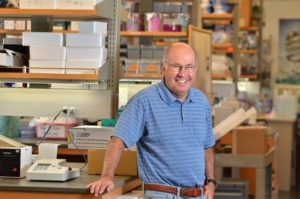
Vaccines are crucial to the health of millions in developing countries, but timely delivery of these lifesaving immunizations has always been hindered by the need for refrigeration. Now, a unique interdisciplinary collaboration at CU Boulder’s BioFrontiers Institute aims to change that.
Professors Robert Garcea, Theodore Randolph and Al Weimer specialize in different areas of biochemistry; but recently, the trio banded together on a multiyear effort to develop shelf-stable, nonperishable vaccines that can be stored at high temperatures for months rather than days.
If successful, such an advancement would radically ease the difficult task of distributing immunizations to rural hospitals and population centers.
The magnitude of the challenge requires a wide range of skill sets and ideas, something that the researchers were all too happy to take on. “It’s really merging three different people with three different sets of expertise into one project,” Garcea said.
In Garcea’s lab, investigators work on new vaccines such as those for human papillomavirus (HPV), a leading cause of cervical cancer that is particularly devastating to women in developing countries.
One corridor away, Randolph’s team, which focuses on creating stable dosage forms for therapeutic proteins and vaccines, developed a process for making vaccines thermostable, or resistant to damage from heat or cold. In its final form, this vaccine resembles a glassy powder.
The two began collaborating about two years ago and even formed a spinoff company, Vitravax Inc., which has seen encouraging results in mice thus far.
Weimer contributed the final piece of the puzzle. His lab coats the vaccine microparticles with protective layers of aluminum oxide, a process known as atomic layer deposition. This nanometer-thick barrier shields the vaccine particles while helping trigger the body’s immune response.
The trio are now forming extended-release vaccine dosage forms. When the formulation is injected, the outer layer provides an initial vaccine dose. Next, the aluminum oxide layer slowly dissolves, eventually releasing the inner core, which acts as a second dose of vaccine. Patients receive their second or third “dose” without ever knowing it and without a return trip to the doctor.
Individual results have been promising, but scaling from test batches in the lab to manufacturing millions of vaccines for public use is a challenging process that might not succeed quickly—or at all. “We’ve done many of the individual parts of this project,” Randolph said. “Now we’ve got to put those pieces together and have it work.”
Still, the professors say they are optimistic about the collaboration, which might never have happened if not for their proximity on CU Boulder’s East Campus and the interdisciplinary mission of the BioFrontiers Institute, which drives innovation by combining researchers from different fields.
“One of the hopes of the BioFrontiers Institute is that investigators will, by their proximity, do new and interesting things,” Garcea said. “In a sense, we’ve fulfilled the mission. If the technology works, we’ve really fulfilled the mission.”
—
Read the original article here.

